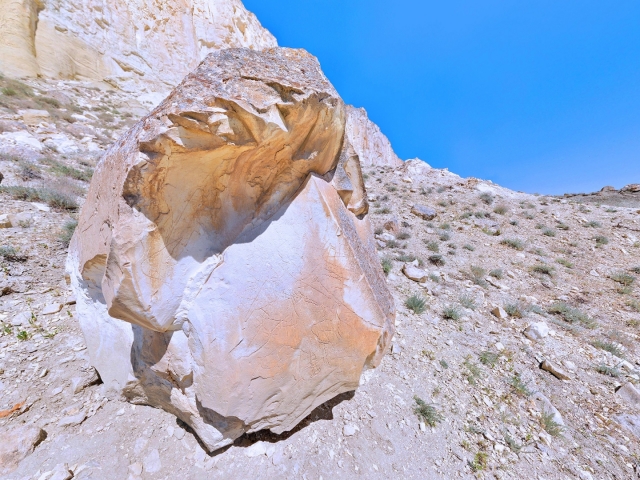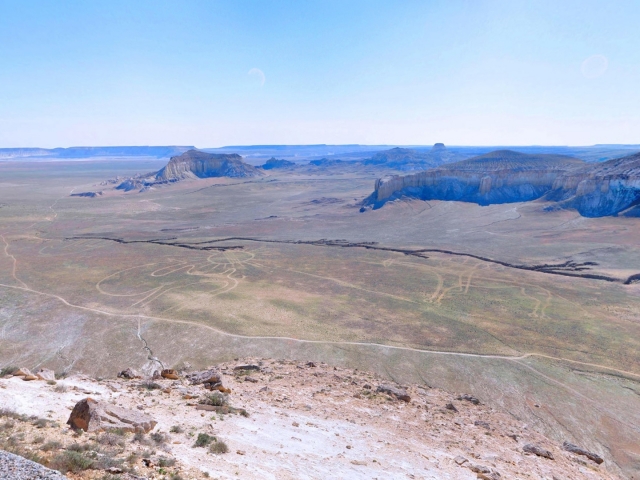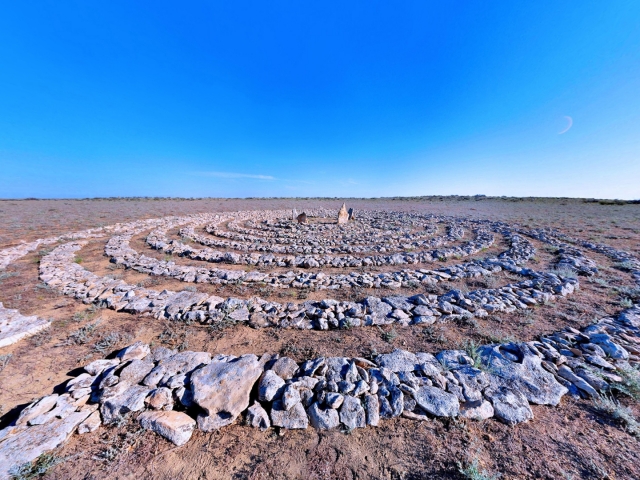Places
List of objects included in the map
Kydyrsha Ata Necropolis
Location: located in Mangistau district of Mangistau region, 86 km to the south-east from Tolep village.
Coordinates: N 44°15' 9.11" , E 55°15' 27.53"
Description of the Monument: Investigated in 2008 by the specialists of Mangystau National Historical and Cultural Reserve, included in the preliminary list of objects of historical and cultural heritage of Mangistau region. In the necropolis 35 objects are marked. In center of the necropolis there is a modern stone fence. At the western wall, inside the fence a wooden pole 'Syryk Agash' with scraps of fabric is installed. In the same area but behind the brick fence there is a modern kulpytas. To the north-east of the fence there is a saganatam. The monument is rectangular, made of sawn limestone slabs without foundation, on a footing course; it has a tree-layer structure with stone masonry in the middle. Doorways are facing the south. To the east there is another saganatam similar to saganatam no. 1; at the western wall a kulpytas is installed. In the same part of the necropolis there are stone fences with sellae, kulpytasses and koitasses.
Historical Data, Legends and Stories: Kydyrsha Zhylkybaiuly is a known healer and bone-setter. Zhylkybai had 8 children. The youngest was called Kydyrsha. According to legend, Kydyrsha Ata had the power to fix dislocations and fractures, without touching the person. No matter how complex the fracture was, at the threshold of Kydyrsha Ata the bones were set in and of themselves. At that time fractures happened mostly during well clearing or due to a fall from a horse. Once Kydyrsha Ata started a long journey to a patient, damaged bones set into place in and of themselves, crashed bones gradually came together and the patient calmly fell asleep before arrival of the healer. Once Zhylkaidar of Kyrykmyltyk tribe fell from his horse and broke his femur. He sent a man with two horses, so that he brought Kydyrsha to him. As soon as the messenger reached Kydyrsha Ata, the exhausted man immediately fell asleep. Kydyrsha Ata stopped in another house. That night the patient moved his leg. After that Kydyrsha Ata told him to make sacrificial meal 'sadaka'. When a sheep was killed and the meat was cooked Zhylkaidar was called. Surprised relatives asked how it was possible that a person with a broken thigh could stand up. Kydyrsha Ata responded to them: 'Wake him up, he has to get up'. The man waked up and poured water on everybody's hands. Once Kydyrsha Ata had a walk with a group of his friends, horsemen and stopped in the village of Satei-Bi. Local young horseman named Abantai Tekeshuly presented a horse to the healer. Kydyrsha Ata liked his modesty and behavior very much. The next day Abantai put the healer on the horse but Kydyrsha Ata immediately went down from the horse and blessed Abantai. After 3-4 days after departure of Kydyrsha Ata Abantai began to set and heal fractures. This man was also touched by God: bone-setter and healer, he predicted using kumalaks and was able to recognize the foil. Kydyrsha Ata died in 1915. His powers passed on to his descendants. It is said that pilgrims who spent a night at the tomb of Ayagan Ata, the son of Kydyrsha Ata, also got fractures healed. A famous kuishi Shamil Abiltayev broke his leg and walked with crutches; having heard of Ayagan Ata he came to honor him: he spent a night there, and next morning he got on his feet (1993). Kydyrsha Ata died in 1915 His powers pass from generation to generation.
Sources:
- Archives
of Mangistau National Historical and Cultural Reserve;
- 'Famous Man Begei' Begei
Ata Genealogy Almaty, 2007.
Views: 3631
Video
Маршрут
Hazret Yerzhan Burial
Shopan Ata Necropolis and Underground Mosque
Shakpak Ata Necropolis and Underground Mosque (14th–19th centuries)
Khatam-Ishan Mausoleum
The earliest structures here date back to the second half of the 17th c. The necropolis was developed in time and space in a circle, i.e. the most ancient constructions remained in the center. Out of the two extant domed mausoleums, the structure in the southern part of the necropolis is of particular interest. ...









